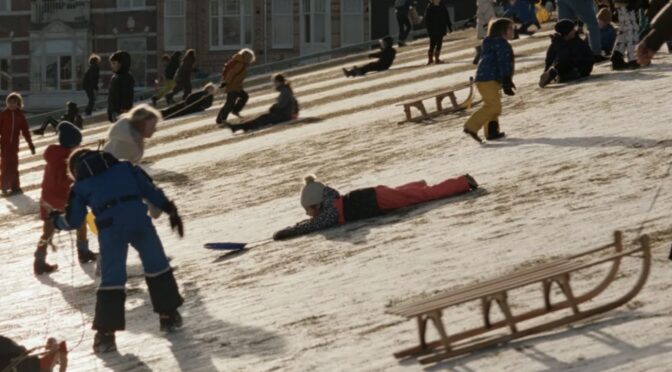It is always a welcome occasion when Steve McQueen announces a new project. This time, the British filmmaker turns his eyes towards Amsterdam, where he has lived for almost three decades. In adapting the book Atlas of an Occupied City: Amsterdam 1940-1945 by Bianca Stigter, the documentary’s narration rolls over footage of modern Amsterdam, with no archival footage in sight.
The camera stays still as life goes on in front of it, and over the noises of a city – chess games in the park, protests in the streets, public health radio announcements – narration dispassionately records the stories behind its houses, streets, and canals during the Nazi occupation. Early in the film, viewers are told that weather broadcasts stopped during this time as they were considered military secrets; that a statement so unbelievable could not only be true but one of the less horrifying facts of life is then illustrated over the next four and a half hours. As the images slowly, silently pan over lists of family names who passed through a theatre-turned-deportation centre to die (often in concentration camps), there is a complete sense of trust in the audience to follow this thorough but tragically incomplete history.
“With its scope, restraint of style, and honesty of content, OCCUPIED CITY is a tremendous achievement in documentary storytelling.”
The Netherlands lost 75% of its Jewish population, the highest percentage of any country occupied by Nazi Germany, in part due to the detailed and comprehensive census records it kept of its population that made it hard for people to flee or change their identities. OCCUPIED CITY visits families house by house, telling stories of deportation and frequently suicide, sometimes of an entire family. McQueen does not necessarily work to keep the stories “fresh” or avoid repetition: he bears witness to details of state-sponsored violence and ensuing hopelessness in their magnitude. That said, these four and a half hours are cut down from the 36 that McQueen filmed; such a document may not work in the cinematic medium, but the fact that these are only a snapshot of the stories that can be told is sobering.
“McQueen resists drawing parallels [with current politics] – his material and mission are set – and the restraint in letting the audience form their own connections with past, present, and probable future events avoids pitfalls of over-interpretation.”
In some ways, it is spiritually uneasy to match the restrictions imposed by the Nazis on civil liberties – notably the human rights abuses committed against the country’s Jewish population – with the social changes that occurred during the COVID-19 pandemic and ensuing lockdowns. Also, the film does not engage too much with current right-wing politics in the Netherlands; nationalist/anti-immigrant movements have become prominent there, as in many European countries, over the past few years. McQueen resists drawing parallels – his material and mission are set – and the restraint in letting the audience form their own connections with past, present, and probable future events avoids pitfalls of over-interpretation.
At the end of each piece dealing with the people who lived, passed through, and died at each address, the fate of the historical building is given. Some still exist, some are modified, and some (often former private homes, usually replaced by new private homes) are signed off with a simple “demolished”. However, by this act of geographic memory, the almost-too-expansive collective grief reveals the impossibility of full remembrance and full oblivion. With its scope, restraint of style, and honesty of content, OCCUPIED CITY is a tremendous achievement in documentary storytelling.

